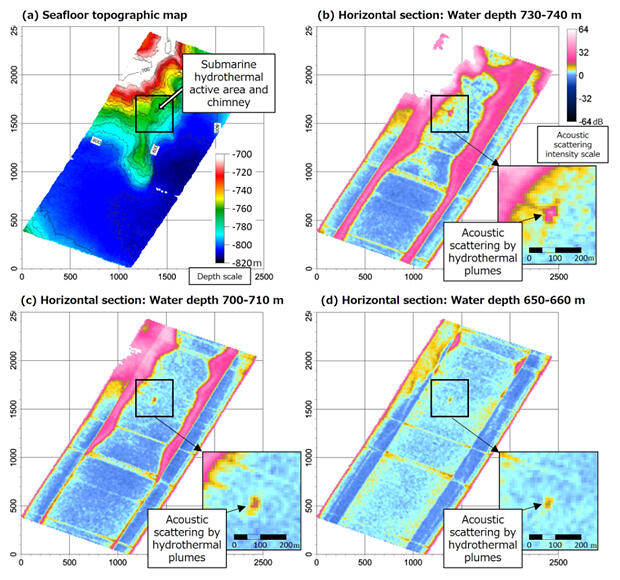A research group led by Deputy Technical Director Junji Kaneko of the Submarine Resources Research Center, Research Institute for Marine Resources Utilization, Japan Agency for Marine-Earth Science and Technology, and Group Leader Takafumi Kasaya, has successfully captured the acoustic scattering of a hydrothermal plume in the Izu-Bonin-Mariana arc for the first time.
Submarine hydrothermal deposits are anticipated to be a source of minerals for Japan, and much research and investigation is still ongoing. Hydrothermal plumes can be observed by multibeam acoustic sounding survey (MBES) equipment on research vessels as an acoustic scattering phenomenon. Many acoustic observations have been conducted mainly in the Izu-Bonin-Mariana arc and the Okinawa Trough, but no acoustic scattering events due to hydrothermal plumes had ever been detected in the arc to date.
The research group worked in the Izu-Bonin-Mariana arc and, to detect acoustic scattering phenomena caused by hydrothermal plumes due to CO2 droplets, targeted an active area already known to exist in the underwater part of the Higashi-Aogashima caldera. Using the submarine research vessel "Kaimei" high-frequency high-resolution acoustic scattering data was acquired through MBES. The acoustic scattering intensity data from underwater areas were converted into a voxel model and visualized in three dimensions, which allowed the researchers to pursue a quantitative interpretation of scattering intensity, geographical location and shape.
When they generated a voxel model from the high-resolution underwater acoustic scattering data they acquired and spatially integrated it with the seafloor topography to visualize and observe the underwater area, they identified peculiar areas of higher scattering intensity than the surrounding area from each depth section. The vertical section of the 3D model confirmed that this peculiar area was a deflected cone-shaped scatterer (about 190 meters high) extending vertically from the seabed near the seafloor hydrothermal active zone and chimney (about 30 meters high).

Provided by JAMSTEC
A quantitative interpretation of the location, shape, depth of extinction and scattering intensity, as well as similarities with hydrothermal plumes found in the Okinawa Trough, allowed them to identify this scatterer as acoustic scattering from a hydrothermal plume containing CO2 droplets originating from seafloor hydrothermal activity. This is the first time that acoustic scattering data from a hydrothermal plume has been acquired by an MBES on board a research vessel in the Izu-Bonin-Mariana arc.
"In the future, we will use this method to explore unknown hydrothermal activity and hydrothermal deposits in various offshore areas and clarify the relationship between hydrothermal plumes and acoustic scattering," commented Kaneko.
■ Hydrothermal plume: A plume containing carbon dioxide, trace heavy metals and other substances derived from submarine hydrothermal activity.
■ Voxel model: A model that represents objects in three-dimensional space by means of a set of rectangular or cubic bodies of the same shape.
This article has been translated by JST with permission from The Science News Ltd. (https://sci-news.co.jp/). Unauthorized reproduction of the article and photographs is prohibited.




